GALLERY PLACE – CHINATOWN CORRIDOR STUDY

FEBRUARY 2023



FEBRUARY 2023

In late 2021, the DowntownDC Business Improvement District (BID) embarked on a year-long study of the 25-block Gallery Place – Chinatown Corridor, both its economic development and public space issues as well as the opportunities it offers. The project team from AECOM analyzed ways to improve the Corridor’s economic vitality, safety, public space management, pedestrian experience, vehicular movement, and public space infrastructure.
The Gallery Place – Chinatown Corridor Study, the result of this effort, is one of several BID planning endeavors that are meant to address the quality-of-life and economic issues currently facing DowntownDC that are the result of several long-term trends and the significant impact of the pandemic. In particular, this study, along with the DowntownDC Parks Master Plan, offers recommendations that will:
1. Make downtown a more attractive place for businesses to operate and residents to live, making DowntownDC more competitive with other D.C. and regional submarkets; and
2. Inform the upcoming DowntownDC –Golden Triangle Action Agenda, which will
provide concrete recommendations for public and private investments, policies, and projects for the DowntownDC and Golden Triangle BIDs in the context of the public and private sectors’ diminished resources.
Thank you to everyone who participated in the effort to produce this study, particularly the members of the Advisory Committee. This document required a multifaceted partnership that reflects the many roles played by the corridor’s public and private stakeholders. The BID is proud of the significant amount of public input received during this process and grateful for the advice and recommendations of AECOM in developing this document.
We look forward to working with the BID’s stakeholders to make a number of the recommendations in these pages a reality.
Sincerely,
 Gerren Price President and CEO
Gerren Price President and CEO
The DowntownDC Business Improvement District (BID) has partnered with stakeholders — including land owners, tenants, and District government agencies, such as DMPED, DDOT, and OP — to imagine the next evolution of the Gallery Place – Chinatown Corridor (the Corridor) at a critical moment in time. This is the cultural and entertainment heart of DowntownDC, at the center of the region, where residents, employees, and visitors from around the globe experience the nation’s capital as a city, not just as the seat of government. Significant public investments in the Gallery Place – Chinatown Corridor energized DowntownDC growth from 1995 to 2005. The Corridor’s combination of regional attractions and robust connectivity give it a magnified visibility among District of Columbia visitors. Perceptions of the Corridor, whether positive or negative, reflect on the entire city. The Corridor has the most diverse combination of land uses in DowntownDC with layered destination districts and employment centers within.

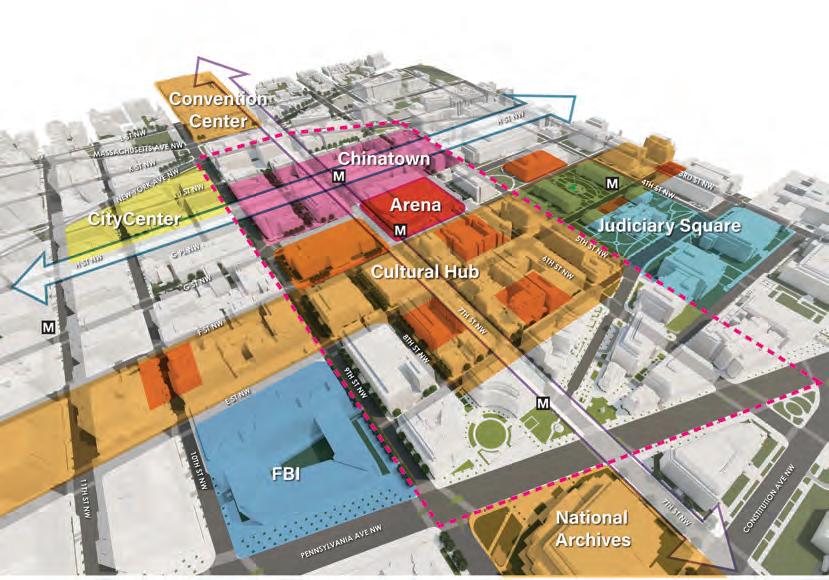
However, the Gallery Place – Chinatown Corridor and DowntownDC face important challenges as they recover from the impact of several long-term trends as well as the COVID-19 pandemic’s economic stresses. This study seeks to document the stakeholder-driven vision for future economic development investments, public policy priorities, and capital improvements needed to strengthen the Corridor. Nearly three decades have passed since major DowntownDC public investments were made. Stakeholders see the need for new investments that support an evolution toward an even stronger economy and improved quality of life.
Chinatown
Cultural / Entertainment
Retail / Shopping
Federal employment
From November 2021 through June 2022, the BID and the planning team engaged a variety of stakeholders through interviews, meetings, focus groups, and public surveys to better understand observations, concerns, and priority needs for the future Corridor. These outreach activities provided essential input from a diverse set of perspectives and informed the vision for Corridor evolution as well as policy priorities and recommended public realm and mobility enhancements. Outreach activities included:
> 30+ stakeholder interviews
> 500+ online sur vey responses
> 4 focus group sessions
> 3 Advisory Committee meetings
> 2 public meetings
The next evolution of Gallery Place –Chinatown will be influenced greatly by market forces. Some will drive changes in land use, while others will cause headwinds that slow the transformation. This study identifies where the market will need assistance, where it won’t, and how the public realm can change in the future to better support a new land use mix. These considerations will also be helpful in planning investments as the city recovers from the pandemic and DowntownDC activity increases.
Major economic development priorities include:
> Accelerating office-to-residential conversions
> Attracting local businesses and shopping retail
> Extending the Capital One Arena ground lease

Owners, tenants, institutions, employers, visitors, and residents have all expressed concerns about perceptions of safety and unwelcoming conditions within the Gallery Place – Chinatown study area. These concerns were present in nearly every conversation. Stakeholders believe strongly that these challenges impact investment decisions, leasing opportunities, and quality of life for local residents and businesses. Because of the Corridor’s regional and national visibility, these concerns have the power to influence perceptions of the District as a whole. Critical issues to address include:
> Visible drug sales
> Aggressive panhandling and disruptive amplified busking
> Percieved increased in people experiencing homelessness
> Capital investments to improve the public realm


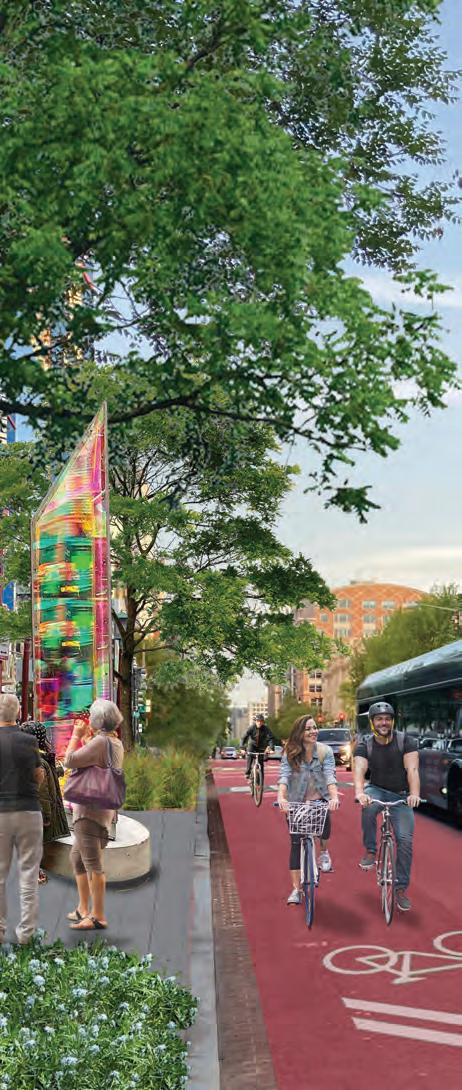
Stakeholders articulated the critical elements of downtown’s next direction and the importance of the Gallery Place – Chinatown Corridor in taking the next step. Synthesized from engagement activities and Advisory Committee discussions, the following statements describe what must drive the next evolution of Gallery Place – Chinatown.
Strengthened policies and enforcement mechanisms to protect public safety, improve visitor perceptions, and improve resident/business experiences while protecting the rights of D.C. residents are needed. The Corridor is in the heart of the District, at the center of the region, and it must be welcoming to all. This stretch of 7th Street NW is the central spine where residents, employees, and visitors merge and interact. Transforming this street will require special attention, as many stakeholders find it unwelcoming today.
The Corridor’s layering of cutural activity, entertainment, dining, and shopping options drive D.C. residents and regional visitors downtown. This must be strengthened to enhance DowntownDC’s definition as a regional destination fueled by Chinatown’s atmosphere and clustered civic and cultural attractions that support significant ground-floor vibrancy. The renewal of the Capital One Arena ground lease is critical to the Corridor’s remaining an entertainment center for the District and the region.
Creating more residential opportunities at all price points is critical to making the Corridor and DowntownDC more active and vibrant. New residential development and conversions of older office buildings to residential will help balance daytime office workers with residential economic drivers.
Expanded pedestrian space is needed in the most congested locations to increase comfort, capacity, and variety in high-activity areas. In other areas, expanded pedestrian space can provide locations for events and gatherings that otherwise require closing streets. Expanded open-space programming offered by local institutions, cultural organizations, and attractions will further define the Corridor as a destination neighborhood.
Additional opportunities throughout the corridor to eat and drink in the public realm are needed. This is the most commonly desired activity by stakeholders of all kinds. There are few opportunities today for outdoor dining compared with other entertainment districts in D.C., and changes in policy and in the public realm itself are needed to create new opportunities.

New and diverse amenities are needed to support residents, local and small businesses, and visitors alike (i.e., neighborhood-serving retail/grocery store, outdoor dining, neighborhood interaction, playgrounds, etc.). In addition to a cleaner, more-welcoming atmosphere along 7th Street, new “quieter” spaces are needed that offer an alternative that is oriented more toward local residents and employees. These needs are also reinforced throughout the DowntownDC Parks Master Plan, a study examining the use of public spaces throughout DowntownDC.
Enhanced transit and multimodal mobility choices are needed in the future to improve ease of access and decrease single-occupancy vehicles, congestion, and emissions. While the emphasis will be on active mobility (walking, cycling, transit, scooters, etc.), it will be important to maintain passenger and delivery vehicle pick-up and drop-off (PUDO) opportunities and parking access to support local businesses, attractions, and residents.


As with the 1995–2005 transformation of DowntownDC, the next evolution of Gallery Place – Chinatown will require investments




in public realm amenities and experiences that provide the activities and atmosphere desired by employees, visitors, and a growing number of residents. These investments will need to create new and expanded spaces for pedestrians within the current public right of way, and help continue a broader Districtwide trend toward active mobility. While not prohibiting personal vehicles outright,

an active transportation system emphasizes walking, transit, bicycling, and other types of personal mobility (scooters, etc.) that support public health and sustainability. Because of the diversity of mobility choice, this approach increases the capacity of streets to move more people into and through Gallery Place – Chinatown.
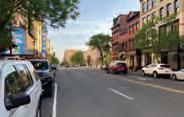
The top 11 action items are identified below along with the partners needed to make changes in policy, allocate funds, or implement capital projects.
The DowntownDC BID and DDOT must partner to secure funding for capital improvements through the CIP and/or private sponsorships and to advance the design for priority interim and permanent improvements through the DDOT process. The D.C. Office of Planning can also play an important role in advising on placemaking and programming opportunities in the design stages and in coordinating a comprehensive set of downtown improvements between BIDs.
The DowntownDC Business Improvement District (BID) is partnering with downtown stakeholders — including land owners, tenants, and District government agencies such as DMPED, DDOT, and OP — to imagine the next evolution of the Gallery Place – Chinatown Corridor at a critical moment in time. This is the cultural and entertainment heart of downtown, at the center of the region, where residents, employees, and visitors from around the globe experience the nation’s capital as a city, not just as the seat of government. Gallery Place – Chinatown energized DowntownDC’s growth over the last 30 years, and its combination of regional attractions and robust connectivity give it a magnified visibility among District of Columbia visitors. Perceptions of this corridor, whether positive or negative, reflect on the entire city. This destination faces important challenges as it recovers from the pandemic’s economic stresses, and this study seeks to document the stakeholder driven vision for future policy priorities and capital improvements needed to strengthen the heart of region.

From 1995 to 2005, the District government focused on the greater Gallery Place – Chinatown Corridor to initiate a downtown renaissance and create a development catalyst for all of the District. Key investments included the Capital One Arena (then MCI Center), the Walter E. Washington Convention Center, and the public realm. Total investments of land and general fund tax revenues was in the hundreds of millions of dollars.

These investments in DowntownDC created a model of downtown development emulated around the country. In addition, these investment strategies were applied to help new D.C. neighborhoods — like the 14th and U Streets NW corridors, H Street NE, the Capitol Riverfront, NoMa/Union Market,The Wharf and Buzzard Point — emerge as new destinations themselves, along with established historic and shopping destinations like Georgetown and Dupont Circle. Further competition is now coming from suburban employment centers such as National Landing,Tysons, National Harbor, and Largo that are beginning to add cultural destinations and appealing public gathering spaces.
These new activity centers are good for the region overall, but renewed attention is needed in the core of the nation’s capital to maintain its employment and tax base strength and cultural and entertainment center of gravity. As identified by stakeholders in this study, there are opportunities in the future — such as the ground lease renewal for the Capital One Arena, the momentum of office-to-residential conversions, office tenant attraction incentives, increased transit accessibility, attraction of new shopping retail, and the transformation of underutilized streets into gathering spaces — that can drive this next evolution.
The Gallery Place – Chinatown Corridor study area (the Corridor) is bounded by Massachusetts Avenue NW to the north, Pennsylvania Avenue NW to the south, 5th Street NW to the east, and 9th Street NW to the west. Uniquely positioned between the Walter E. Washington Convention Center and the National Mall, the Corridor includes numerous culture and entertainment anchors including the Capital One Arena, the National Portrait Gallery, the Smithsonian American Art Museum, the Shakespeare Theatre Company’s Sidney Harman Hall and Michael Klein Theater, the Woolly Mammoth Theatre, and the historic Sixth & I Synagogue.
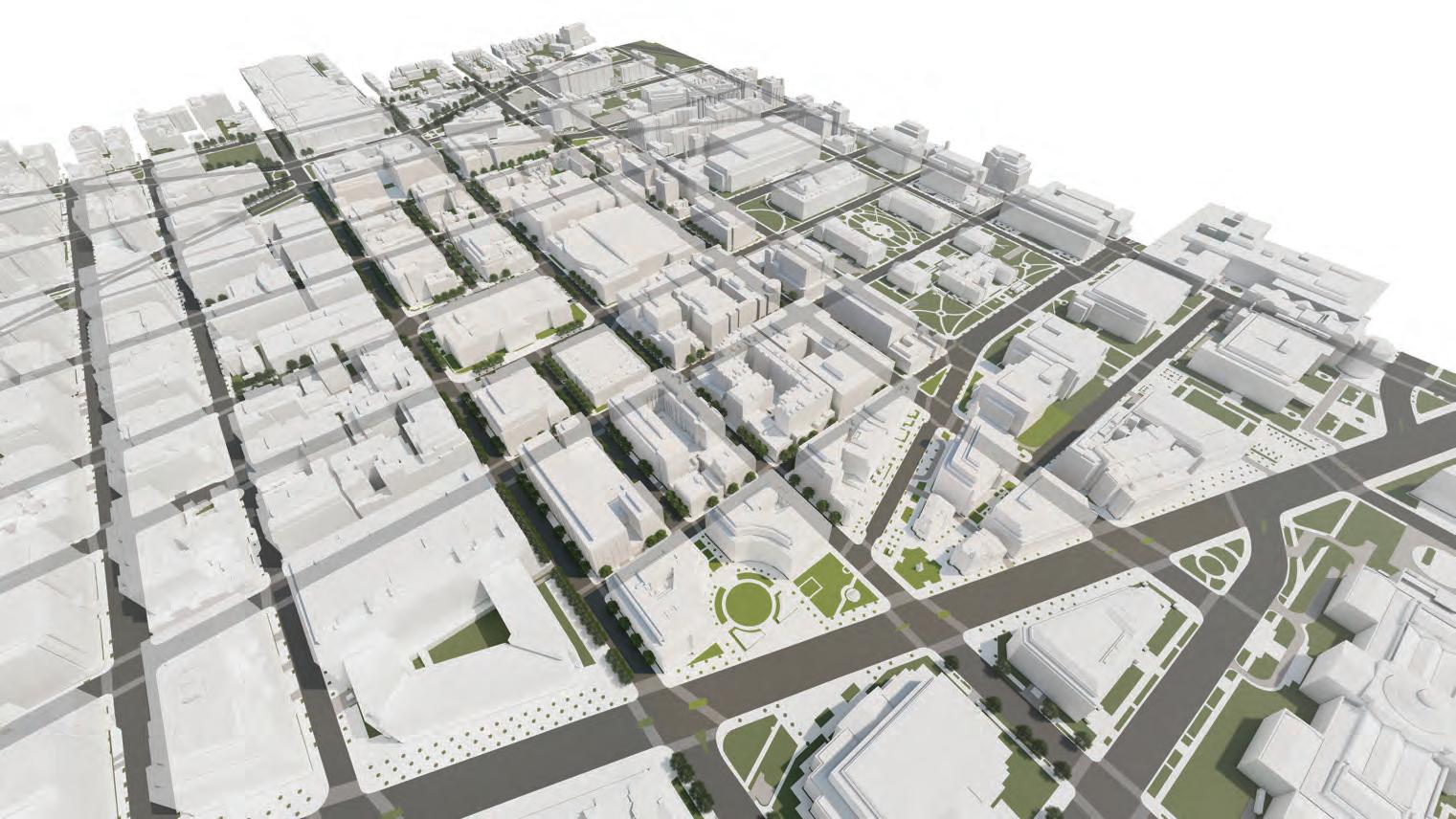






















The Corridor’s urban footprint dates back to Pierre L’Enfant’s 1791 Plan of the City of Washington (the L’Enfant Plan), which envisioned the national capital as a coordinated system of radiating avenues, parks, and vistas overlaid on an orthogonal grid of streets (Figure 6). The Patent Office, now the Smithsonian American Art Museum and National Portrait Gallery, was constructed in the early 19th century on the L’Enfant Plan’s Reservation No. 8, a site L’Enfant proposed for a national nondenominational church. Overall, the L’Enfant Plan’s vision for the Corridor remains largely in place today.

The Corridor lies at the heart of D.C.’s old downtown. In the early 19th century, the intersection of 7th Street and Pennsylvania Avenue NW quickly emerged as the District’s commercial center with the construction of the city’s primary market (Center Market), now the site of the National Archives. While Constitution Avenue connected the east and west routes, the 7th Street corridor served as an important early north-south corridor connecting Maryland farmland to the Center Market and wharves on the Potomac and Anacostia rivers. By 1880, a vibrant mix of residential and commercial uses had developed along 7th Street NW.1
1 National Park Ser vice. 1984 (February). National Register of Historic Places Inventory - Nomination Form. Downtown Historic District. Available: https://planning.D.C.gov/node/593352. Accessed April 22, 2022.
District of Columbia Office of Planning. 2009 (September). District of Columbia Inventory of Historic Sites. Available: https://planning.D.C.gov/ node/924472. Accessed April 22, 2022.
The history of the current Chinatown starts in 1931 after Chinese residents and businesses were displaced from D.C.’s original Chinatown at Pennsylvania Avenue and 4½ Street NW (now John Marshall Way). A new Chinatown was formed between 5th and 7th streets NW, where Chinese residents and businesses sought to reestablish their homes, businesses, and culture. Chinatown continued to grow with the establishment of Chinese schools, clubs, entertainment facilities, a community church,
and community organizations. By 1970, approximately 3,000 Chinese Americans and Chinese immigrants resided in Chinatown. However, Chinatown’s population dwindled to less than 600 residents by 1978 as a result of factors such as the city’s rising crime rate, higher taxes, a deteriorating business climate, and urban renewal efforts. In the
1980s, many bold initiatives were undertaken to strengthen Chinatown, including the Wah Luck Housing Project, the establishment of the Downtown Historic District, the
construction of the Friendship Archway at 7th and H streets NW, and the formation of the Chinatown Steering Committee. Although today’s Chinatown includes colorful Chinese-influenced buildings and signs, restaurants, and businesses, Chinatown as an ethnic enclave has continued to decline. As of 2009, less than 300 Chinese residents remain in and around Chinatown.2 However, area organizations are active in coordinating programming and business interests among stakehoders. As identified in the DowntownDC Parks Master Plan, there are opportunities to enhance Chinatown Park that can further strengthen the community.
The Corridor is a central focal point for the BID’s and the District’s art, culture, and entertainment, as well as the BID’s residential population. Although the Corridor is only approximately 16% (or 0.16 square miles) of the total BID area, the Corridor accounts for approximately 20% of the BID’s commercial real estate, nearly 30% of the BID’s residential population, and 20% of the BID’s jobs as of April 2020. The Corridor continues to the be the heart of DowntownDC and an important regional activity center but needs the same level of 2 District of Columbia Office of Planning. 2009 (June).
Chinatown Cultural Development Small Area Plan. Available: https:// planning.D.C.gov/publication/chinatown-cultural-developmentsmall-area-action-plan. Accessed April 22, 2022.
recent investment as D.C.’s other submarkets to keep the Corridor thriving and resilient.
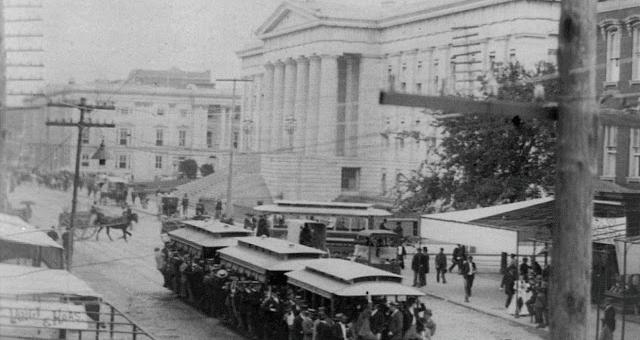
The opening of the Capital One Arena (MCI Center) not only created a downtown home for D.C.’s professional sports teams, but also provided a multipurpose entertainment center that has hosted as many as 210 events per year with an annual attendance of approximately 2.5 million. The arena and nearby anchor attractions help drive visitation from the region to the Corridor, boosting spending at local restaurants, bars, and businesses (see page 41).
Theaters in the Corridor are an important economic driver, often with performances six days a week. In 2019, Corridor theaters had approximately 400,000 attendees.
Despite being “off the Mall,” the Corridor also contains two flagship Smithsonian institutions, the National Portrait Gallery and the Smithsonian American Art Museum, which bring an additional 1.5–2 million visitors per year.
Similar to many downtowns nationwide, the Corridor has experienced severe economic impacts from the ongoing COVID-19 pandemic. Economic recovery in the BID is currently back on a steady, yet slow, track. As of May 2022, Capital One Arena’s attendance was at approximately 95% of pre-pandemic levels, with theater attendance at 40%–70%. Theater fans have been enthusiastic to return, but longer lead times for new productions will slow the recovery.
In May 2022, museums were operating on a modified schedule with an overall attendance at 50%–75% of pre-pandemic levels. As of May 2022, economic activity overall in the BID was at 47% of pre-pandemic attendance levels, driven largely by reduced office occupancy. By comparison, economic activity was at 40% in winter 2022, 33% in fall 2021, and 16% in winter 2021 compared with
pre-pandemic levels. While recovery steadily moves on, there is substantial economic uncertainly going forward amid work-fromhome trends, Metro’s uncertain operational and financial capacity, the decline in federal demand for private office space, and potential downtown zoning changes.
The corridor also serves as one of the region’s largest transit hubs. Thousands of pedestrians, transit riders, bicyclists, and drivers move to and through the Corridor

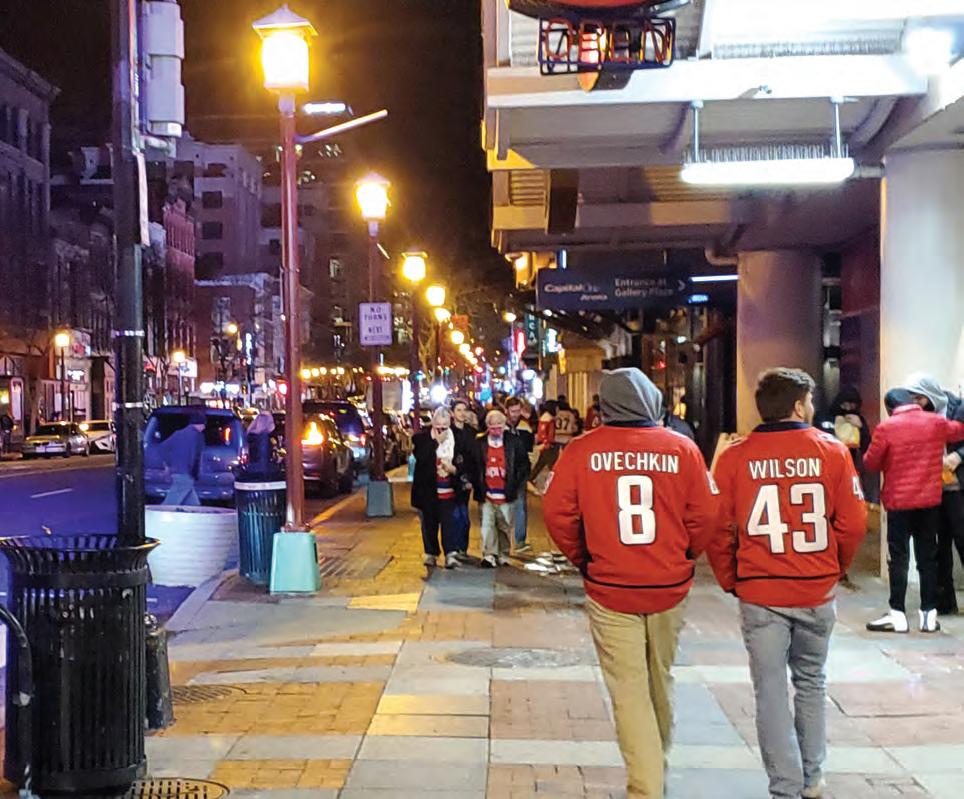
each day. Pedestrian space can become congested, especially near transit transfer points, and vehicular traffic can complicate critical bus services along 7th and H streets that serve the entire city. Event traffic can coincide at times with the evening commute, complicating mobility for all modes.
DDOT data shows that in 2017 this segment of 7th Street carried an average of 15,000 vehicles per day and supported 3,700 bus
boardings and 2,800 bus alightings. Roughly half of these boardings occur at H Street, where the greatest number of rail-to-bus and bus-to-bus transfers take place. Even though significant space exists for pedestrians (over 16% of the corridor area is sidewalk or plaza space), that space isn’t located where it’s most needed (i.e., adjacent to major pedestrianoriented destinations on 7th Street). Although the Corridor is well connected,
the pedestrian experience lacks the seating and dining opportunities found in emerging entertainment destinations around the District. The Corridor’s current streetscape and public spaces support very few activities overall. The pathways can be congested and make many feel uncomfortable, unwelcome, or unsafe at critical locations and times, especially on arena event days. And the sidewalk conditions have degraded with heavy use.

https://wtop.com/washington-capitals/2018/05/photos-washington-capitals-win-game-7-head-stanley-cup-final/ https://www.bizjournals.com/washington/news/2018/06/08/stanley-cup-parade-details-coming-into-focus.html

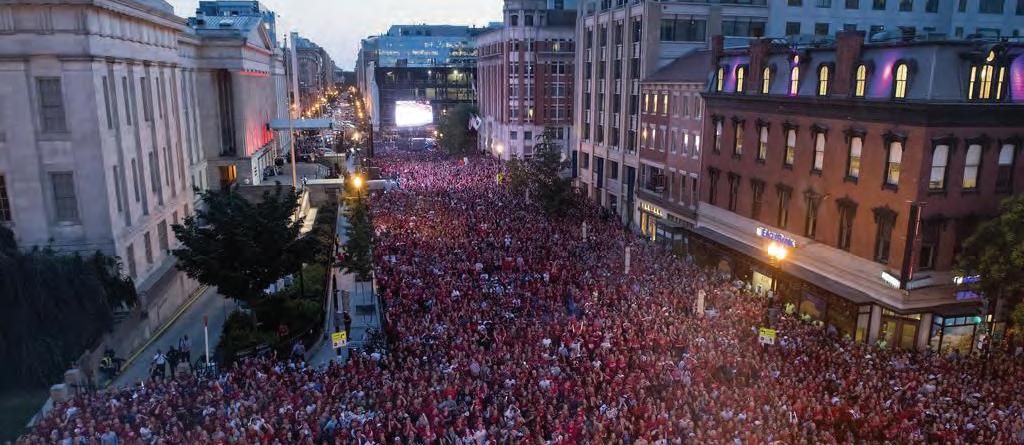
From November 2021 to May 2022, the BID engaged a variety of stakeholders through interviews, meetings, focus groups, and public surveys to better understand ideas, concerns, and needs for the future of the Corridor. These outreach activities provided essential input from a diverse set of perspectives and informed the vision for Corridor evolution as well as policy priorities and recommended public realm and mobility enhancements.

More than 30 stakeholder interviews were conducted from December 2021 through early February 2022 to discuss opportunities and challenges facing the greater Gallery Place – Chinatown area. The project team interviewed major anchors, institutions, entertainment and tourism organizations, hotels, restaurants, property managers and owners, developers, neighborhood organizations, and residential representatives.
An Advisory Committee consisting of BID constituents and D.C. government partners met three times over the course of the study to review the study’s progress, findings, and provide feedback. During Meeting #1 on November 18, 2021, the planning team introduced the Corridor study and discussed key challenges and questions related to real estate economics, mobility and circulation, and the public realm experience and amenities. During Meeting #2 on January 19, 2022, the project team presented a snapshot
Table 2: Advisory Committee
D.C. Office of Planning (OP)
District Department of Transportation (DDOT)
D.C. Office of the Deputy Mayor for Planning and Economic Development (DMPED)
AARP
Clyde’s at Gallery Place
Clyde’s Restaurant Group
Douglas Development (invited)
Events DC
Hotel Monaco
Monumental Sports & Entertainment
Oxford Properties Group
Shakespeare Theatre Company
Smithsonian American Art Museum
Leslye Howerton, Associate Director for Urban Design
Ellen Jones, Chief Project Delivery Officer
Megan Kanagy, Mass Transit Branch Manager
Sarosh Olpadwala, Director of Real Estate
Debbie Armenti, Senior Vice President, Business Operations
Kelvin Nwosu, General Manager
Kevin Keller, Director of Operations
John McDonnell, President
Norman Jemal, Managing Principal
Greg O’Dell, President and Chief Executive Officer
Greg Leinweber, Director of Sales and Marketing
Monica Dixon, President, External Affairs and Chief Administrative Officer
Josh Turnbull, Gallery Place General Manager
Chris Jennings, Executive Director
Amy Hutchins, Marketing and Communications Manager
of the Corridor’s real estate economic context; key takeaways from the stakeholder interviews and a public intercept survey; and a draft vision for the Corridor. Committee feedback on what best meets and does not meet future needs of the Corridor’s public realm and mobility was sought through a series of visual preference activities through the interactive platform MURAL, a live online whiteboard. During Meeting #3 on March 17, 2022, the project team presented priorities
for the public realm and mobility, health and safety, and economic development. The Committee then reviewed and discussed potential improvements along reimagined key streets in the Corridor.


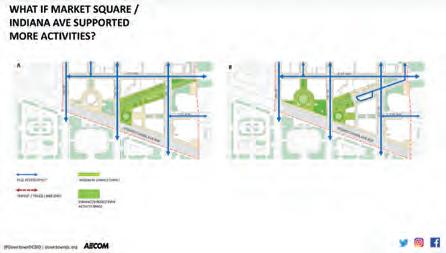
Public engagement efforts kicked off with an online intercept survey made available from December 19, 2021, to February 28,
2022. The survey was accessible through a QR code on large A-frame signs and fliers distributed by the project team during the Downtown Holiday Market and before a Washington Capitals game at the Capital One Arena. Large A-frame signs were rotated throughout the Corridor area, and fliers were placed at popular locations including Clyde’s of Gallery Place, Hotel Monaco D.C., Bang Salon, Sidney Harman Hall, and Gregory’s Coffee. The survey was also distributed via the BID’s email list.
Survey participants were asked:
> What typically brings them to the Corridor?
> When do they typically visit?
> How do they typically travel to the Corridor?
> How do they feel when walking along 7th Street NW and other streets in the Corridor?
> What activities they would like to do more?
For a chance to win a $100 gift card to a DowntownDC restaurant, please take a 7-minute survey to share how your experience in Gallery Place-Chinatown can be improved!

Take the survey at slido.com | #558 283

Brought to you by:
> What would make getting around Gallery Place – Chinatown more enjoyable?

The survey received over 500 responses. A majority of participants who offered their zip code information live in Washington, D.C. (approximately 82%), with 45% of those respondents from DowntownDC (zip codes 20001 and 20004). The remainder were from surrounding jurisdictions or from outside the metropolitan area.

What typically brings you to Gallery Place – Chinatown?
How do you feel when you walk along 7th Street in Gallery Place – Chinatown?
Which activities would you like to do more of in Gallery Place–Chinatown?
Restaurants
How do you typically travel to Gallery Place – Chinatown?
How do you feel when you walk along other streets in Gallery Place – Chinatown?
I like the vibrancy, activity, and people watching
I like the vibrancy, activity, and people watching Walk
What would make getting around Gallery Place – Chinatown more enjoyable?
Clean and well-maintained public spaces
Wider sidewalks
More outdoor dining areas
Dedicated bike lanes
More trees and planting areas
question (respondents selected 3 for each question from a longer list of choices)



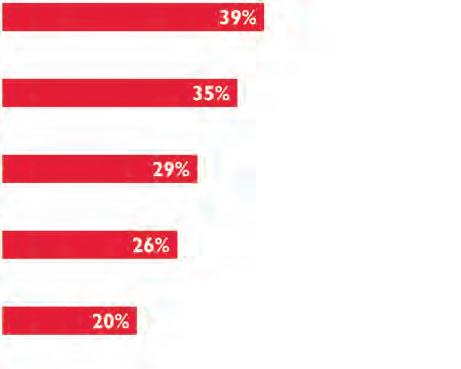


Figure 11: Public survey word cloud result to “Use one word to describe Gallery Place-Chinatown”
Figure 12: Public survey open responses to “How do you feel when you walk along 7th Street in Gallery PlaceChinatown?”
“7th Street is _okay_, but I rarely find myself wanting to go that way. The convention center and the arena are not built with a human-scale streetscape.”
“If there is an event at the stadium, it feels inviting and lively, but other times of the week, it feels a bit unwelcoming.”
“I do feel unsafe at times but not because of crime, it’s because of cars and car traffic.”

If 7th Street were reimagined, which activities would you most enjoy in this new public space?


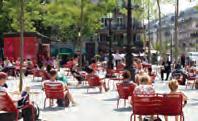
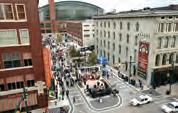
Eat & drink outside
People watch
Interact with & appreciate art
If F and G Streets were reimagined, which activities would you most enjoy in this new public space?



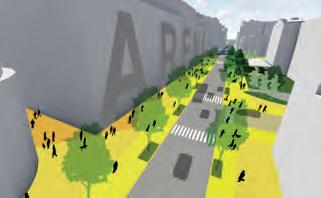



Eat & drink outside
Interact with & appreciate art
Attend a performance or event
If the space near 6th and H Streets were reimagined, which activities would you most enjoy in this new public space?
> Learn about histor y & culture
> Converse with friends
> Eat & drink outside

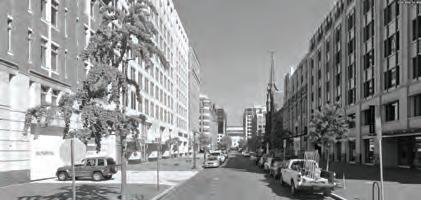
If 8th Street were reimagined, which activities would you most enjoy in this new public space?
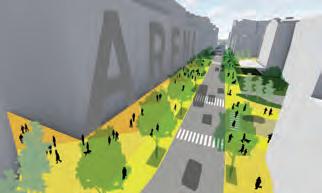



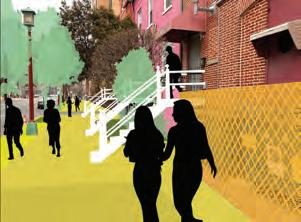
Eat & drink outside
Attend a performance or event
Interact with & appreciate art
On February 17, 2022, a joint public meeting with the DowntownDC Parks Master Plan project team was held to summarize the Corridor study’s and the Parks Master Plan project’s community-identified needs in the public realm; review data analysis and observations; and present strategies for infusing the BID area with higher quality parks and public spaces. Approximately 60 individuals participated in the meeting. An interactive live online polling app was utilized, and attendees were asked about what types of activities they would enjoy most in public spaces along specific reimagined streets within the Corridor, with a summary of the top three selections for each street shown in Figure 13.
The project team then held meetings to further discuss proposals for 7th Street NW with staff from the District Department of Transportation (DDOT) as well as two focus group sessions with Corridor tenants on March 8 and 9, 2022, and two sessions with Corridor property owners and managers on April 15 and 18, 2022. Participants discussed potential options for 7th Street and defined priorities for future improvements.
On May 26, 2022, a public meeting was held to prioritize recommendations identified by stakeholders. Approximately 30 individuals participated in the meeting. An interactive live online poling app was utilized, and attendees were asked to provide feedback on action items that were most important to residents living in Downtown and specific locations to enhance in the near term.
The following high-level overview of stakeholder and public feedback, organized into themes, was used to shape goals and strategies for the Corridor.
> Safety and Comfort: The perception of safety and feeling comfortable in the Corridor is a major issue across all stakeholder groups and the public. This includes vehicle and pedestrian conflicts, bicycle facilities, clean streets, noise nuisances, and personal security. In particular, visible drug sales, increased presence of those experiencing homelessness and disruptive panhandling and amplifed busking were noted as specific challenges. Enhancing safety and comfort should be a priority objective for the Corridor area.
> Expanded sidewalks: Stakeholders consistently described the need for wider sidewalks and larger pedestrian spaces to accommodate desired activities and to reduce congestion, especially along 7th Street. However, stakeholders wanted to make sure a strategy for managing, policing and maintaining widened sidewalks and a network of gathering spaces throughout the Corridor was in place prior to changing the built environment.
> Neighborhood Atmosphere: Residents in and around Gallery Place – Chinatown would like to see more neighborhood-serving amenities like small-scale grocery, convenience stores, and playgrounds. There’s also overwhelming interest in support for local businesses and opportunities for outdoor seating and dining in high pedestrian activity areas and along quieter side streets.
> Anchor Attractions: The Corridor is uniquely positioned between the convention center and the National Mall with numerous important anchor attractions, including the arena, cultural venues, and restaurants. It’s important to consider the needs of these anchor attractions, including pedestrian access, opportunities for pick-up and drop-off (PUDO) zones, managed parking, and programmable outdoor spaces. While the crowds and congestion associated with
the Capital One Arena were noted as challenges, a majority of stakeholders felt the arena was an important attraction that helped drive dining opportunities and other entertainment-oriented attractions.
> Public Realm Programming: Many anchors and local businesses have an interest in bringing their talents in culture and entertainment to enhance the public realm, providing immersive visitor experiences that would support downtown vibrancy.
> Branding: Downtown would benefit from place-based branding that is concise and identifiable. There is also an opportunity for people to learn about Chinatown history and culture, and interact with and appreciate music and art in public spaces.
> Active Mobility Emphasis: Moving through the Corridor efficiently is challenging, and there’s an opportunity to enhance the experience for MetrorailMetrobus transfers at the intersection of 7th and H Streets with more pedestrian amenities. There’s also an opportunity to transform the public realm experience for pedestrians and cyclists through DDOT’s bus transit priority effort along 7th Street.
The following chapters incorporate feedback from stakeholders and the public.
The transformation of the Gallery Place – Chinatown Corridor from 1995 to 2005 helped reinvigorate downtown, and it was led by significant District government investment, significant federal investment from the General Services Administration (including the legacy projects of the Pennsylvania Avenue Development Corporation), and the Smithsonian Institution. The opening of major civic venues, such as the Capital One Arena (then MCI Center) and Walter E. Washington Convention Center, investments in cultural destinations like Woolly Mammoth Theatre, the Shakespeare Theatre’s Harman Hall, the Spy Museum, the Smithsonian American Art Museum and National Portrait Gallery, the Newseum, and new streetscapes and transit activity helped draw new employers, visitors, and residents into the heart of D.C. More than two decades have passed since those major investments began, and DowntownDC stakeholders see the need for new public investment to enable a further evolution toward an even stronger economy and improved quality of life for the corridor.


Stakeholders articulated the critical elements of DowntownDC’s next direction and the importance of the Gallery Place – Chinatown Corridor in taking the next step. Synthesized from engagement activities and Advisory Committee discussions, the following statements describe what must drive the next evolution of Gallery Place – Chinatown.
Strengthened policies and enforcement mechanisms to protect public safety, improve visitor perceptions, and improve resident/business experiences while protecting the rights of D.C. residents are needed. The Corridor is in the heart of the District, at the center of the region, and it must be welcoming to all. 7th Street NW is the central spine where residents, employees, and visitors merge and interact. Transforming this street will require special attention, as many stakeholders find it unwelcoming today.
The Corridor’s layering of cutural activity, entertainment, dining, and shopping options drive D.C. residents and regional visitors to DowntownDC. This must be strengthened to enhance DowntownDC’s definition as a regional destination fueled by Chinatown’s atmosphere and clustered civic and cultural attractions that support significant ground-floor vibrancy. The renewal of the Capital One Arena ground lease is critical to the Gallery Place – Chinatown corridor remaining an entertainment center for the District and the region.
Creating more residential opportunities at all price points is critical to making the Corridor and DowntownDC more active and vibrant. New residential development and conversions of older office buildings to residential will help balance daytime office workers with residential economic drivers.
Expanded pedestrian space is needed in the most congested locations to increase comfort, capacity, and variety in high-activity areas. In other areas, expanded pedestrian space can provide locations for events and gatherings that otherwise require closing streets. Expanded open-space programming offered by local institutions, cultural organizations, and attractions will further define the Corridor as a destination neighborhood.
Additional opportunities throughout the corridor to eat and drink in the public realm are needed. This is the most commonly desired activity by stakeholders of all kinds. There are few opportunities today for outdoor dining compared with other entertainment districts in the District, and changes in policy and in the public realm itself are needed to create new opportunities.

New and diverse amenities are needed to support residents, local and small businesses, and visitors alike (i.e., neighborhood-serving retail/grocery store, outdoor dining, neighborhood interaction, playgrounds, etc.). In addition to a cleaner, more-welcoming atmosphere along 7th Street, new “quieter” spaces are needed that offer an alternative oriented more toward local residents and employees. These needs are also reinforced throughout the DowntownDC Parks Master Plan, a study examining the use of public spaces throughout DowntownDC.
Enhanced transit and multimodal mobility choices are needed in the future to improve ease of access and decrease single-occupancy vehicles, congestion, and emissions. While the emphasis will be on active mobility (walking, cycling, transit, scooters, etc.), It will be important to maintain passenger and delivery vehicle pick-up and drop-off (PUDO) opportunities and parking access to support local businesses, attractions, and residents.
The next evolution of Gallery Place – Chinatown will be influenced greatly by market forces. Some will drive changes in land use, while others will cause headwinds that slow the transformation. This study identifies where the market will need assistance, where it won’t, and how the public realm can change in the future to better support a new land use mix. These considerations will also be helpful in planning investments as we recover from the pandemic and downtown activity increases.
Major economic development priorities include:
> Accelerating office-to-residential conversions

> Attracting local businesses and shopping retail
> Extending the Capital One Arena ground lease
The Corridor’s strength lies in its clustering of regional attractions and connectivity.

Chinatown
Cultural / Entertainment
Retail / Shopping
Federal employment
The Corridor has a similar program composition to the BID, with office being the dominant use. The Corridor is a central focal point for the BID’s retail experience, residential population, with a critical mass of the BID’s art, cultural and educational institutions. Historically, DowntownDC as well as U Street NW have served as the city’s entertainment hubs. That concentration of visitation is becoming more dispersed throughout the city, with entertainment venues, new attractions, and excellent dining at the St. Elizabeth’s Campus, the Capitol Riverfront, Union Market, the Wharf, and Buzzard Point.
Before the pandemic, the Corridor accounted for roughly:
> 20% of the BID’s commercial real estate
> 30% of the BID’s resident population
> 20% of the BID’s jobs
> 4 million visitors annually from the Capital One Arena and the Corridor’s museums and theaters
> 2.3 million visitors annually combined from downtown and the adjacent prominent anchors, including the convention center, the National Building Museum, and Ford’s Theatre
> 100,000 visitors per day when there is a convention and an arena event
The following summary statements describe the broad real estate trajectory for each market sector in the next evolution of the Corridor and DowntownDC.
Office will play a reduced role despite the diverse offerings, an evolving tenant mix (growing tech focus), and increased residential conversions. Office vacancy likely to increase over the next few years from 16% in May 2022 to 20%. The number of workers in offices in May 2022 stood at 37%–39% and is likely not to exceed 70% due to large growing numbers of people working from home. Large office property tax revenue likely to continue to decline over the next several years. In FY 2022, large office property tax revenues declined by $120 million from FY 2021.




Apartment rents and occupancy are at record levels and condo prices are strong. Combined with high office vacancy rates, there are strong incentives for some office buildings to be converted to residential. With limited ground-up development sites remaining, conversions will be a major source of new residential units.
Strong demand for hotel rooms in the Corridor, even luxury products, are expected to continue. However, during the pandemic the drop in business travel, especially convention-related business travel, reduced the financial stability of hotels, but in April and May 2022, BID hotel revenues jumped to 90% of pre-pandemic levels.
Retail programming will cater to an expanding residential population and support the corridor being a destination neighborhood (grocery, etc.). Shopping inside the corridor is declining with the closure of Bed, Bath and Beyond, Ann Taylor, and Urban Outfitters. Just outside the corridor Anthropologie, Forever 21, J. Crew, and the Gap also closed. Several retail entertainment businesses have opened including Five Iron Golf, The Puttery, and Kraken Axes. Many new destination restaurants are opening to replace the many that closed during the pandemic. By the end of 2022, the number of destination restaurants open in the BID should be greater than in February 2020.
Strengthened branding and programming between Chinatown, the Capital One Arena, significant off-Mall museums, the theater cluster, and the growing higher-education presence will celebrate the Corridor as an arts, culture, and civic hub. The Capital One Arena, museums, theaters, cinemas, and other performance venues are recovering from low entertainment demand and the government required closures of 2020 and 2021. The 2023/2024 completion of the John Hopkins University facility at 655 Pennsylvania Avenue NW will bring hundreds of students to the Corridor. In addition to its role as a central arts, culture, and entertainment district, the Corridor is helping DowntownDC become an education hub.

Currently the dominant use of Corridor (and downtown) buildings, office space needs will likely decrease due to competition from other D.C. and regional submarkets and the permanence of working from home. Downtown is still a desirable location for the federal government and tenants who need access to government clients.
• The BID’s office rents — which are higher than the rest of the District and the region — have been supported by its proximity to federal agencies and amenities of public transit, high-quality dining, and cultural and entertainment venues.
• Broader vacancy trends over the last five years reflect a citywide “flight to quality” to newer buildings, while overall demand has stagnated.
• Unlike most other downtown markets, office rent in D.C.’s broader center city is priced at a premium over multifamily. This creates a challenge for office-toresidential conversions.
• The GSA has moved offices out of downtown to other D.C. submarkets and outside of the city, as rent costs are lower outside of downtown.
• For FY22, the District government reduced the appraised value of large office buildings by 10%, which reduced the District’s office property tax revenue by $120 million per year.
• Stakeholders have shared that building owners are still offering record rent concessions into 2022, resulting in 15%–20% of precovid net effective rents.
• The numerof workers in the office as a percentage of pre-pandemic levels is low: 37%–39%.
Reduced role and with an evolving tenant mix.
• The presence of technology-based companies in the Corridor may help address pandemic softness overtime.
o These tenants are looking for highly amenitized neighborhoods, which the Corridor currently is, with transit access; restaurants; and art, culture, and entertainment.
• Competition for office tenants will remain intense, particularly from submarkets with a greater mix of uses.
• The margin between office and multifamily rents may continue to shrink due to persisting record office rent concessions, both generous tenant-improvement allowances and many months of no rent.
Conversions from office space to residential units are happening, but slowly due to economic and physical constraints. Additional support is needed to accelerate conversion rates.
> Conversions require an empty building. All conversions announced to date are from single-tenant buildings.
> Office properties are valued too high by owners, thus acquisition prices for conversions are cost-prohibitive.
> Many office buildings across DowntownDC have outstanding loans, and debt burden further challenges financials.
> The rent difference for office compared to residential still favors office in DowntownDC, if one can fully lease a building. However, the difference in rents per square foot between office and residential is beginning to narrow.
> Rising construction costs make conversions more challenging.
> Zoning uncer tainty: continued interest by the Zoning Commission in applying inclusionary-zoning requirements to conversion projects in downtown is causing great uncertainty in the conversion market.
> Affordability requirements commonly absorb the benefit gained from tax incentives, leaving projects with continued economic challenges and no incentive to not wait for a better office market.
> The cost of conversions can be just as costly or more expensive than new construction because:
- Large floor plates complicate conversions
- Density and setback limitations hinder ability to increase scale
- Properties along 5th Street NW are further constrained by Commission of Fine Arts review under the Shipstead-Luce Act
- Properties in the Pennsylvania Avenue District Corporation area have additional constraints
Residential conversion is most likely to be successful when the following criteria are met:
> An office building is empty or office leases are expiring in the near term (very important).
> The building has narrower floor plates: around 40–80 foot depths and less interior space unusable/non-revenuegenerating due to light and air regulations for residential uses.
> Older buildings (pre-1970s) likely have a smaller floor plate, less existing debt, and a long-term owner with reduced return expectations.
> Long-term owners, or nonprofit, associations, and trust ownership, are more likely to have a lower cost basis and willing to sell with lower return expectations or be a development partner compared with REITs.
> Rent prices drop for office, so residential becomes more attractive. The city could lose another $50–$150 million per year in office property tax revenue if this were to occur.
> The building has existing below-grade parking.
Recent District government support:
> The FY 2023 budget includes incentives for affordable conversion units.
Residential market demand is strong in the Corridor, the BID, and all of D.C. for both apartments and condominiums. Growing the residential population is an important part of diversifying downtown real estate and providing an 18-hour market for neighborhood-serving businesses.
• The Corridor has seen virtually no multifamily housing growth over the last decade, as there were no remaining residentially zoned, ground-up development sites.
• The only housing built between 2000 and 2015 in the Corridor or the BID was due to zoning requirements or was built on District-owned land.
• The Corridor has consistently had a lower multifamily rental vacancy rate and higher rents/prices than most of the rest of D.C., both before and during the pandemic.
• The Corridor has had rents substantially above other residential rents/prices.
• Compared with peer downtowns, D.C.’s broader center city has one of the smallest multifamily unit densities and population densities per square mile.
• There was high turnover in rental units during the second half of 2020, but occupancies and rents bounced back during 2021.
Expansive potential role in the Corridor by supporting local retail in the wake of reduced office utilizations.
• Currently, there is strong demand in the Corridor, BID, and District for residential:
o Robust access to transportation to easily travel throughout the city.
o Offers walkability to work as well as the city’s prominent arts, culture, and entertainment institutions.
• Needs residential support services to foster a vibrant, expansive resident population, particularly the following:
o grocery store
o pet care
o parks and green space (including dog parks)
o dry cleaner
o barber shop/hair salon
The Corridor, a significant dining destination, has lost over 200,000 square feet of shopping over the past three years and lacks an abundance of neighborhood amenities, particularly a grocery store. Assistance is likely needed to attract shopping options and support local businesses.
• Pre-pandemic retail vacancy rates in the BID of 8%–10%.
• Robust restaurant and bar scene.
• Lacks destination shopping and neighborhood retail that would best support residential life.
• Many Corridor and BID retailers are dependent on office workers and convention attendees, as well as arena, theaters, and museum attendance.
• Vacancy rates in the BID and Corridor skyrocketed: 20% vacant in the BID in May 2022.
• Current vacancy clustered along 7th Street and F Street.
• BID restaurant sales were below pre-pandemic levels between April 2020 and March 2022, but by May 2022 restaurant sales are 10%–20% above pre-pandemic levels and stronger than the rest of D.C. and the region.
• Corridor has a disproportionately large share of BID’s current retail vacancy (40%).
• Current rents may be as low as 50% below pre-pandemic levels.
• Destination restaurant demand is strong.
• Office-serving restaurant activity remains depressed.
• The future of shopping is unclear; there is significant competition from established destinations outside the District.
• The future of entertainment retail seems strong based on several recent openings and announcements.
The Corridor can grow its hotel options as shown by several new hotel investments in, and adjacent to, the Corridor. However, limited development sites are available.
• Pre-pandemic, the Corridor and BID were strong hotel markets, with occupancies of over 75%, and stronger than the rest of D.C.’s hotels.
• Hotel rates in the BID, center city, and all of the District are rebounding slightly faster than in the Corridor.
Economic indicators suggest there is demand for more hotels in the Corridor, including luxury products:
• There are four hotels (1,400 rooms) in the Corridor, 13% of the BID’s inventory compared with the Corridor’s 16% share of the BID’s area.
• There are seven hotels (3,444 rooms) within two blocks of the Corridor.
• Customer profile: primarily business- and convention-related travel, followed by leisure tourism.
• Occupancy in the rest of D.C. was greater than in the Corridor and downtown, primarily due to a decline in business travel, particularly convention-related business travel.
• A 274-room Royal Sheraton hotel began construction in 2021 a few blocks outside the Corridor.
• A 433-room Arlo Hotel began construction in 2022 a few blocks outside the Corridor.
• Two other hotel projects with an estimated room count of 300 have been on hold since February 2020.
These destinations drive the layered Corridor character and identity. The Capital One Arena brings 2–2.5 million people to DowntownDC each year. Its 30-year ground lease expires in 2027. Other groups of anchor Institutions are described below:
• Four of DowntownDC’seight theaters/performance venues are located in the Corridor.
• Branding Opportunity: The BID has a competitive edge, with many prominent theaters and performance venues clustered in and around the Corridor.
• The theaters are a constant and consistent economic driver, often with performances six days a week.
• Parking can be a major issue when performance attendees must compete with arena attendees for spaces.
• Generally reopened in fall 2021; as of May 2022, attendance was at 40%–70% of pre-pandemic rates.
Three of DowntownDC’s twelve museums are located in the Corridor.
• Despite being off the Mall, the Corridor has two flagship Smithsonian institutions — the National Portrait Gallery and the Smithsonian American Art Museum (free admission) with the National Building Museum and the Ford’s Theatre historic site adjacent.
• Pre-pandemic, the corridor lost two significant institutions:
o The Newseum permanently closed.
o The International Spy Museum moved to a larger facility south of the Mall.
• In April–May 2022, museum attendance was at 50%–70% of pre-pandemic levels.
• A growing institutional sector, in and around the Corridor, with two of the District’s many universities.
• John Hopkins University is consolidating all D.C. academic activities at the former Newseum site, a 300,000-square-foot building at 655 Pennsylvania Avenue NW.
• Georgetown University:
o The School of Continuing Studies, which has doubled in size since opening in 2013, is in the Corridor.
o Owns seven other buildings just outside the Corridor, including the nation’s largest law school and the under-construction McCourt School of Public Policy.
• These institutions bring another source of residential and retail demand: faculty and students.
> The opening of the arena 25 years ago, in December 1997, jump-started the renaissance of this area and of D.C. in general.
> The arena still plays a significant role, but other dynamics do as well: Walter E. Washington Convention Center, new hotels, residential developments, tech office tenants moving in, mixeduse projects like CityCenter just outside the corridor, new theaters coming to the corridor, and more.
> The arena’s ground lease expires in 2027.
> Annual attendance: 2–2.5 million per year.
> The ground-floor businesses in the Corridor could not generate the level of pre-pandemic revenue without the arena, as evident by the 2020 performance when the arena was dark.
> Building loans (especially office) are underwritten with the understanding that the arena is in the neighborhood.
> Museum crossover on game days: the adjacent Smithsonian museums see Washington Capital’s fans visit the museum before games, and the street in front of the Smithsonian American Art Museum was the center of the Capital’s 2018 Stanley Cup championship celebration.
> Inside — tickets (all events): $100 average ticket price x 2.2 million attendees = $220 million
> Inside — concessions/merchandise: $25 per capita x 2.2 million attendees = $55 million
> Outside — retail/dining/parking: $30 per capita x 2.2 million attendees = $66 million
> Total: $341 million
> Portion of total from non-D.C. residents: $225 million (66%)
> Spor ts teams benefit from a healthy civic environment, which the Corridor provides to a large extent.
> The arena is a magnet that brings people downtown and supports local businesses. However, it is also seen as a fortress with a not very inviting presence on 6th Street.
> Noise levels outside the arena on event and game days is a challenge for the adjacent office and residential population.
> Approximately $34 million in gross tax revenues (sales and admissions taxes).3
> Approximately $22 million in gross tax revenues attributable to visitors. Approximately 70% of attendees (1.5 million) are drawn from outside District of Columbia.
> The majority of this spending and fiscal revenue takes place within the Corridor.
> Arena attendance supports other attractions within the Corridor.
> Assuming an alternative program on the arena site — 1,000 units, 300 hotel keys and 100,000 square feet of commerical space — the gross tax generation (sales plus property taxes) of the same ground area is estimated to be $17 million per year.
Over the past five years estimates of the arena’s gross tax revenues have ranged as high as $50 million.
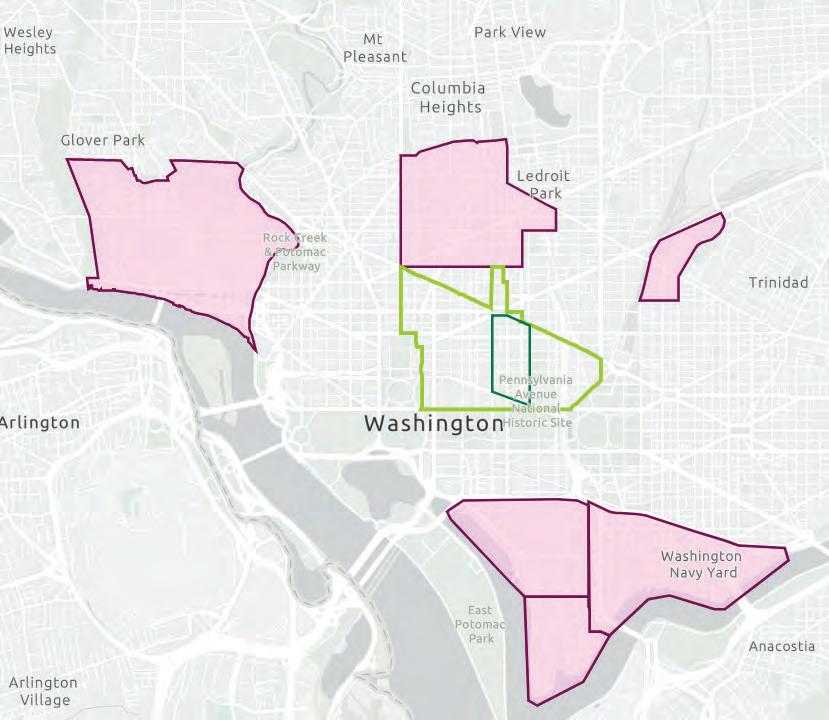
In order to get a sense of how the BID and the Corridor compare with other competitive areas in the city, a sample of neighborhoods was selected for a demographic and real estate comparative analysis. These places were selected to benchmark the BID against successful mature (Georgetown), maturing (14th/U Street/Shaw), and up-and-coming neighborhoods experiencing more significant transformations (Union Market, Navy Yard, Wharf, Buzzard Point).

Comparison Neighborhoods:
> Georgetown
> 14th Street / U Street / Shaw
> Union Market
> Navy Yard
> Wharf
> Buzzard Point

The BID and the Corridor have been built out with limited residential zoning or other residential requirements, so they have not kept pace with fast-growing multifamily neighborhoods, despite demand.
> The Corridor’s multifamily market has high rents and condominium prices relative to peer neighborhoods.
> Another indication of demand,is the Corridor’s low apartment vacancy rate, the lowest among analyzed peer neighborhoods.
Three-quarters of the Corridor and BID’s real estate is private office, according to CoStar data.
No other competitive neighborhood surveyed approaches that figure. Most have much higher percentages of residential.
The Corridor’s retail sector, which had low vacancy before COVID, has struggled more than peer neighborhoods since the pandemic started.
> Corridor retail rents were at a premium pre-pandemic.
> Retail in the corridor is more office-dependent than peer neighborhoods.
> Shopping has declined; luxury shopping is doing well.
> Destination restaurants are doing well; office-serving restaurants are struggling.
> Downtown struggles to attract/retain local retail.
The Corridor and DowntownDC had a very strong hotel market before COVID.
> Hotel markets across all D.C. neighborhoods have suffered since the start of the pandemic.
> Hotels are staying afloat on leisure travel as business/ convention travel has been slow to return.
> In April and May 2022, BID hotel revenues jumped to 90% of pre-pandemic levels.
Owners, tenants, institutions, employers, visitors, and residents have all expressed concerns about perceptions of lack of safety and unwelcoming conditions within the Gallery Place – Chinatown study area. These concerns were present in nearly every conversation. Stakeholders believe strongly that the challenges impact investment decisions, leasing opportunities, and quality of life for local residents and businesses. Because of the Corridor’s regional and national visibility, these concerns have the power to influence perceptions of the District as a whole. This visibility grants the Corridor an amplified voice. The quality of experience throughout Gallery Place –Chinatown, and the message that it sends, reflects strongly on the District in both positive and negative ways.

Many stakeholders identified the perception that the Corridor was less safe than it had been previously. Crime data, compiled and reported by the Metropolitan Police Department (MPD), can be used to understand the patterns in what crimes have been reported and where, over a given time period, and compare them to perceptions. The following charts and maps from MPD describe the incidents of reported violent crime in the DowntownDC BID and reported locations within the study area over the last five years.
The total number of reported violent crimes in the DowntownDC BID since May 2017 was 44.2% less than the preceding five years, with robberies accounting for the largest portion of the total. Overall reported violent crime was down 33.2% across the entire District over the same time period. While the DowntownDC totals are higher that other large BIDs, it is important to note that the rate of reported incidents per 1 million SF of built space is lower. Current stakeholder perceptions seem to reflect the opposite. This could be due to the spike in robberies between 2019 and 2020 and assaults in 2021. It can also be due to the relative lack of eyes on the street during the pandemic and the perception that criminal activity is more visible in recent years.
Source: https://D.C.atlas.D.C.gis.D.C.gov/crimecards/ https://ctycms.com/D.C.-capitol-riverfront/docs/2021_annual_report.pdf

https://www.nomabid.org/wp-content/uploads/2021/12/NoMa-DevMap-Nov2021.pdf
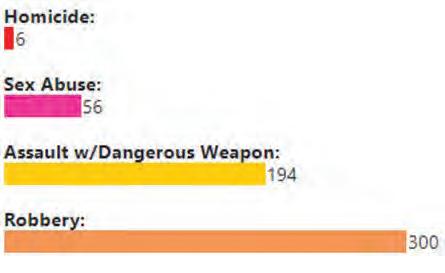
(May 2017–May 2022) source: https://D.C.atlas.D.C.gis.D.C.gov/crimecards
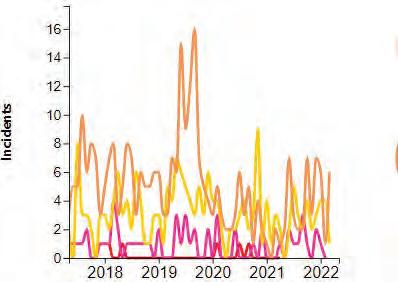

Locations of reported violent crime in the DowntownDC BID appear to be distributed evenly west of 10th Street NW and North of E Street NW. Similarly, there is a cluster of reported locations within the Gallery Place – Chinatown study area. Overall, these patterns seem to mimic locations of greatest pedestrian activity and population density. This is similar in other BIDs, where the most incidents are reported where most people live and work. Within the Gallery Place – Chinatown Corridor, there appears to be a higher frequency of reported crime within two blocks of the 7th Street NW and H Street NW intersection.


https://D.C.atlas.D.C.gis.D.C.gov/crimecards
Looking beyond crime data, there are several challenges that combine to create negative perceptions and experiences in the Corridor. Though the are independent issues, with different causes and context, they are often mentioned together. These distinct but compounding issues include:
> Visible drug sales
> Growing presence of people experiencing homelessness
> Panhandling and disruptive busking

Much is already being done by the District and the DowntownDC BID to address these issues, but the pandemic has exacerbated the complex challenges, and additional attention is needed to improve quality of life for all.
Beyond the games, beyond the movies, giving people a sense that there’s a place where they belong, reminding people that someone cares about them, I think that’s what’s most important.
—Downtown D.C.
Reverend James D. Ross

The virtual garden is the signature element of the center, and the designers worked hard to make it feel comfortable, and even exhilarating.
—G. Martin Moeller, Jr. ArchitectureDC Magazine
The Downtown Day Services Center located at 1313 New York Avenue, NW is offering WALK-IN services Monday through Friday from 9:00 am –5:00 pm. Lunchtime meal service is offered daily from 11:00 am to 1:00 pm. Saturday & Sunday meals only available at Vermont Avenue, NW. For questions or additional information, contact The Downtown Day Services Center via phone: 202-383-8810 or e-mail: Center@DowntownDC.org.
Help support the Center’s efforts. Visit DowntownDCFoundation. org or give at: downtowndc.org/donate.
I don’t want to just say we’re being treated humanely. It exceeds the humane level.
—Robb, DDS Client
Stakeholders reported seeing open drug sales activities in several areas within the study area, most commonly along H Street NW or in alleys between H and I Streets. This severely undermines the goal of creating safe and welcoming public space.
Advocate for stronger police presence to disrupt drug sales activities. This can also help monitor panhandling and busking related challenges.
In addition, increased legitimate street-level activity will act as its own deterrent for criminal activity. Drug sellers will be less likely to engage in the activity where they feel highly visible to many people.
Private security can be hired to oversee specific locations.
Stakeholders reported perceiving an increase number of people sleeping in downtown public space in recent years. Data collected by the BID shows that the average annual number of individuals outside overnight has gone down from 2020 to 2021, while the average annual number of tents or encampments has increased significantly over the same period. Within the study area, the perceived visibility increase could be explained in part by the recent lack of typical activity.
Advocate for non-MPD support–increase the involvement of Crisis Intervention Officer (CIO) to support individuals and families and orient them to needed services, CIOs are part of a collaborative program between the MPD and the Department of Behavioral Health (DBH).
Advocate for additional capacity in day use centers and overnight accommodations.
Panhandling is seen by many as a significant nuisance that threatens the downtown experience
Panhandling laws, even based on “aggressive behavior,” can be deemed unconstitutional if they are too broad.
Amplified musicians have created conflicts with adjoining businesses and residences, especially those that become “captive audiences.”
Advocate for amplified noise legislation, and better enforcement, that can deter disruptive sound levels in nearby businesses and homes.
Advocate for a no-cost panhandling permit process. This permit, without cost or onerous identification requirements, can help educate individuals on safe, lawful behavior.
Through a process similar to the parklet and streateries permitting, empower businesses to manage public space where they operate outdoor dining facilities.
As in the previous transformation, the next evolution of Gallery Place – Chinatown will require investments in public realm amenities and experiences that provide the activities and atmosphere desired by employees, visitors, and a growing number of residents. These investments will need to create new and expanded spaces for pedestrians within the current public right of way and help continue a broader District-wide trend toward activity mobility. While not prohibiting personal vehicles outright, an active transportation system emphasizes transit, walking, bicycling, and other types of personal mobility (e.g., scooters) that support public health and sustainability. Because of the diversity of mobility choices, this approach increases the capacity of streets to move more people into and through the Gallery Place –Chinatown Corridor.

The Corridor’s streetscapes offer the greatest opportunity to support new activities and amenities and as such, stakeholders often discuss mobility related enhancements and public realm improvements simultaneously. Throughout the interviews, surveys, focus groups and public forum, many locations for potential improvements were discussed. The Advisory Committee reviewed these locations and considered where private development was planning to invest in public space already as well as the overall list of desired activities and experiences.
In an effort to focus proposed improvements where they would have the greatest benefit, the Advisory Committee and planning team narrowed the options to:
> The length of 7th Street NW
> F and G streets NW surrounding the gallery

> The length of 8th Street NW
> The segment of 6th Street NW north of H Street connecting to I Street NW adjacent to Chinatown Park



Within these focus areas, four key priority improvement areas were identified where the public realm experience and mobility enhancements would have the greatest benefit to current and future stakeholders.
Can be more welcoming to pedestrians (wider sidewalks) and can support better bus transit.
Can better support events and signature gatherings in the heart of the Corridor.
Can become a neighborhoodoriented amenity, offering a relaxing alternative to the hustle of 7th Street.
Can help tell the story of Chinatown while improving access to businesses and cultural destinations.
Stakeholder-identified opportunities areas for improved public realm experience

Priority areas for public realm and mobility improvements
Key corridors described in the DowntownDC Parks Master Plan
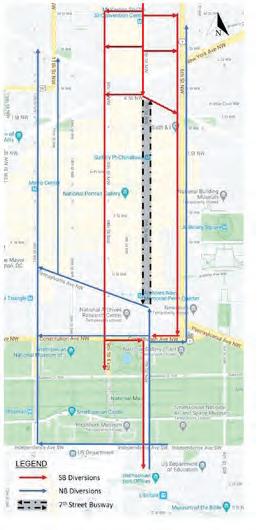
The 7th Street NW corridor is a critical part of the District’s bus transit network, as it connects several neighborhoods with services and provides important connections to high-volume east/west bus routes and the Metro rail system. As the District emphasizes active mobility and seeks to move more people in sustainable ways, 7th Street has been identified as an important link in the bus priority system.
In 2020, DDOT proposed prioritizing bus, truck, and bicycle traffic on 7th Street through the Corridor and restricting access to passenger vehicles. 7th Street stakeholders appreciated the proposed expansion of the sidewalks but opposed losing the ability for pick-up and drop-off (PUDO). These activities were seen as vital to restaurants and residents, especially during the pandemic, when food delivery kept many in business.

DDOT’s initial concept removed the outer parking lanes, expanded the sidewalk space on both sides, and used a combination of three lanes to move buses, trucks, and bicycles north and south. Commercial loading spaces were provided on the corridor. PUDO spaces were provided on the cross streets. Stakeholders’ concern was the lack of accommodations for adequate PUDO on 7th Street for ride hailing, deliveries, and general drop-off.
In collaboration with DDOT, DowntownDC and the planning team explored several additional options that sought to realize the benefits of expanded sidewalks and bus priority while providing limited vehicular access for PUDO. The diagram below depicts several of these alternatives, each incorporating some level of mixed traffic and dedicated space for PUDO and commerical loading activities. Through a series of

focus-group discussions, Alternative 4 was identified as having the best combination of attributes. including expanded sidewalks and PUDO possibilities on both sides of the street. DDOT identified that camera technologies being deployed as part of the broader bus priority system could be used to monitor limited vehicular access to and from PUDO locations and enforce rules for entering and exiting 7th Street following PUDO activities.
This option will allow limited vehicular access to and from PUDO areas only on each block.
 Figure 22: Diagrams depicting alternative ways of achieving bus priority and limited car access for pick-up and drop-off (PUDO) activities as well as commercial loading.
Figure 22: Diagrams depicting alternative ways of achieving bus priority and limited car access for pick-up and drop-off (PUDO) activities as well as commercial loading.
The main activities desired along 7th Street NW include outdoor dining, interaction with art, and additional circulation space, and stakeholders also reviewed options that focused on where expanded sidewalks should be located. The symmetrical sidewalks expansion was preferred, as it provided equitable options for amenities and PUDO.


Expand sidewalks asymmetrically to prioritize pedestrian flow adjacent to the arena.


Expand sidewalks symmetrically to create possibilities for outdoor dining and additional circulation space on both sides of the narrowed street.
Preferred by stakeholders

67% of Public Meeting #1 participants (highest ranked choice) want to “eat and drink outside” more throughout the Corridor
Existing condition
59% of Public Meeting #2 participants (highest ranked choice) thought the blocks from F Street to H Street were the highest priority locations for enhancement along 7th Street
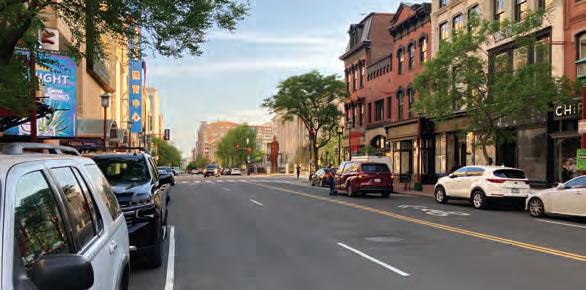
 Figure 23: Artist’s illustration of potential permanent improvements to 7th Street
Figure 23: Artist’s illustration of potential permanent improvements to 7th Street

Stakeholders also identified the need to make improvements along 7th Street quickly as the Corridor rebounds from the pandemic and the prospect of more office-to-residential conversions grows. As has been done in Georgetown and other downtowns around the world, interim improvements can be made that expand pedestrian space without the added cost of moving permanent utilities. These tactical improvements can also be used to test locations and sizing of PUDO areas, outdoor dining amenities, and more.
 Figure 24: Precedent examples of interim streetscape enhancements that create space for desired activities
Figure 24: Precedent examples of interim streetscape enhancements that create space for desired activities

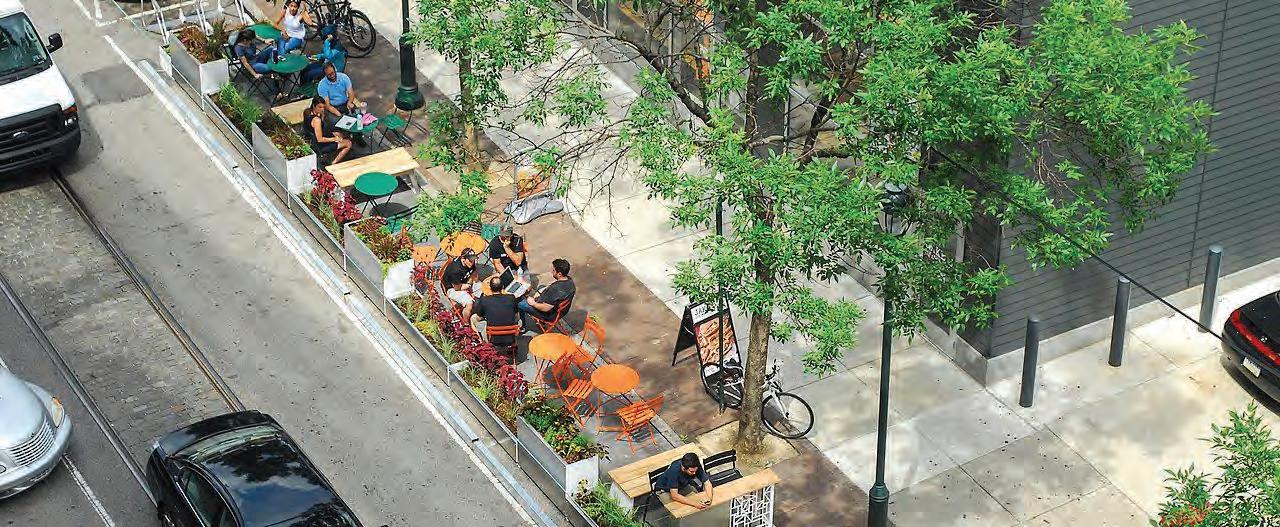


The 6th and H street NW intersection has acted as the is the unofficial heart of Chinatown as the neighborhood has evolved. It is a unique location where culturally oriented businesses, religious institutions, and residents converge. Due to the historic nature of several buildings and their necessary access, HVAC and waste pickup functions happen along 6th Street in the public right of way.
A modest streetscape renovation could rebuild context-sensitive entrances to the businesses and 6th & I synagogue as well as screen the service functions with art that helps tell the story of evolving culture in and around Chinatown.
Figure 25: Looking north along east side of 6th Street (existing condition)51% of survey respondents ranked “Clean and well-maintained public space” as what would make getting around the Corridor more enjoyable.
47% of public meeting participants (highest ranked choice) want to “learn more about history and culture” at 6th and H Streets.
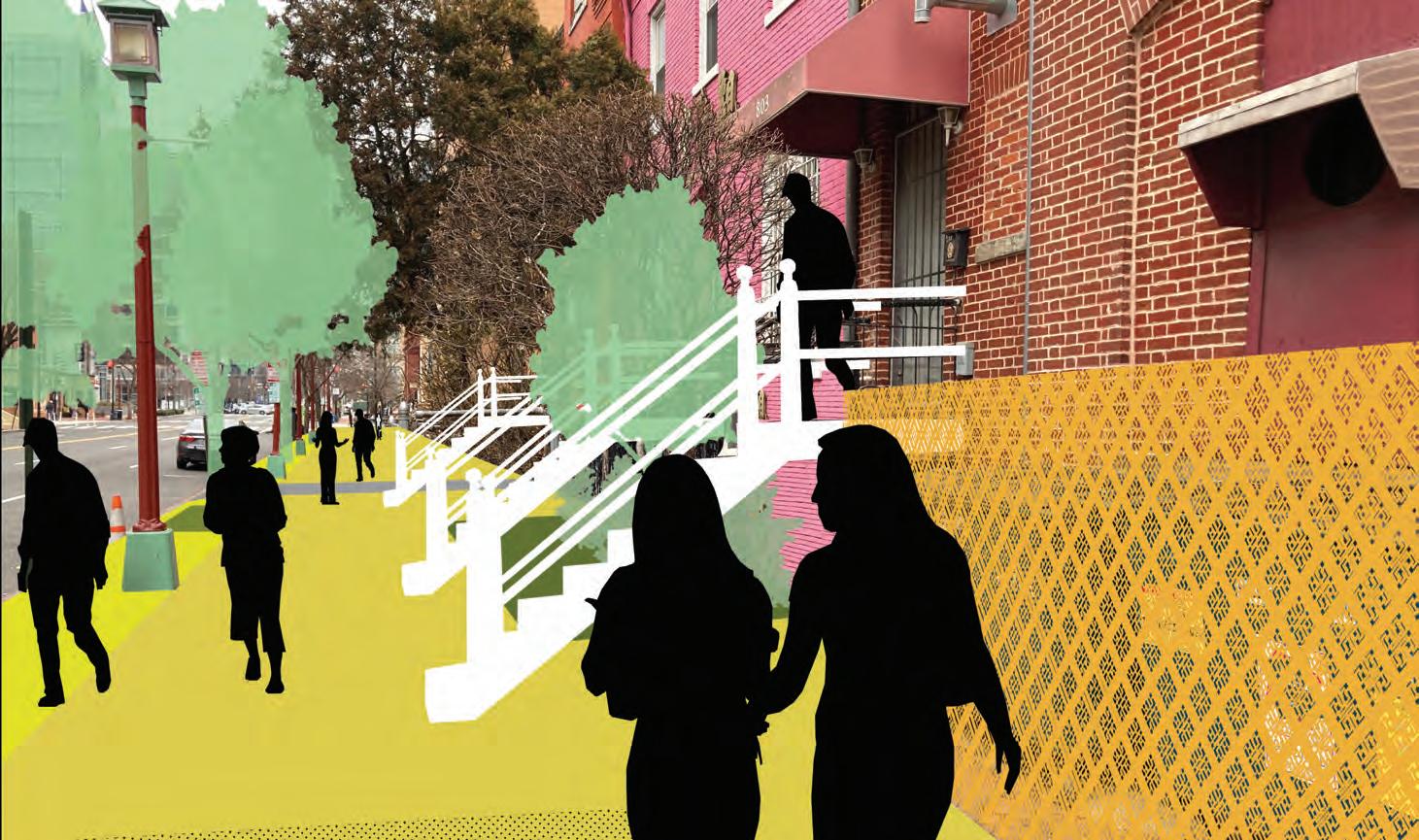 Figure 26: Artist’s illustration of potential improvements to 6th Street
Figure 26: Artist’s illustration of potential improvements to 6th Street
Two approaches to 8th Street NW were discussed with the Advisory Committee and the public. Both maintain vehicular access to the garages and entrances of existing buildings but reallocated the right of way differently to create contiguous pedestrian space. The first option splits 8th Street into two oneway streets with a center occupiable median. The second includes one two-way street but shifts it off-center to create contiguous plaza space on one side. In both options, the streets could be flush with plaza grade and shared with pedestrians as woonerfs (shared pedestrian and calm vehicular street). In each case, vehicles would move slowly and calmly through the narrow shared space.
Stakeholders gravitated toward the second option because it reduced the shared pedestrian and vehicular space. Along the length of 8th Street, the woonerf could change in its location within the right of way to maximize pedestrian amenity and minimize driveway lengths to adjoining buildings.
The southern segment of 8th Street, between F and D streets NW, was prioritized for earlier implementation because it connects one of downtown’s most occupied public spaces, Market Square/Navy Memorial, with the gallery and attractions along F Street. This space is also well suited to complement the vibrancy of 7th Street, including amenities oriented to nearby residents such as quiet, flexible seating areas, interactive art, conversational spaces, and (potentially) spaces for play.

Split the vehicular traffic into two one-way streets flush with a plaza-like median.
Create a narrow, asymmetrical woonerf (shared pedestrian and calm vehicular street) with expanded plaza space.
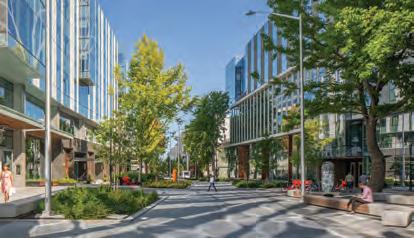
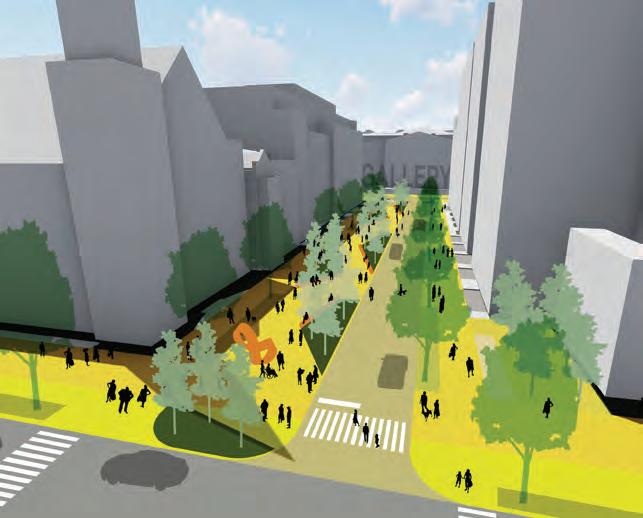
Preferred by stakeholders

30% of survey respondents want to “relax in a park” more.

Existing condition
 Figure 27: Artist’s illustration of potential improvements to 8th Street
Figure 27: Artist’s illustration of potential improvements to 8th Street
F Street NW is well suited to increase its role in hosting major events. By narrowing F Street to calm two-way traffic and PUDO, the plaza adjacent to the gallery can be expanded. Stakeholders gravitated toward an option where the street was a flush woonerf that could be easily closed to create one large plaza for concerts and gatherings. While the 700 and 800 blocks are the primary location, this idea could be extended eastward to 6th Street, the stretch in front of the arena.
Reduce the width of F Street to expand the plaza adjacent to the gallery. Continue to allow two-way traffic and pick up and drop-off activity but in a narrow street.



Reduce the width of F Street and convert it into a woonerf and expanded plaza adjacent to the gallery and businesses to the south. Continue to allow two-way traffic and PUDO activity. Retractable bollards can be installed at intersections to make closing the street easier and more welcoming than using temporary barriers and police vehicles. Preferred by stakeholders


40% of survey respondents want to participate in more “outdoor festivals and performances.”

Existing condition
 Figure 28: Artist’s illustration of potential improvements to F Street
Figure 28: Artist’s illustration of potential improvements to F Street
The following summarizes the key next-step action items, responsible parties, and approximately timelines for key initiatives and capital improvement projects.

The top 11 action items are identified below along with the partners needed to make changes in policy, allocate funds, or implement capital projects.
1 Advocate for MPD presence + private security presenceOffice of the Mayor + D.C. Council + DowntownDC BID
2 Advocate for amplified noise regulations
3 Advocate for accelerated office conversion support
4 Advocate for additional support for those experiencing homelessness
5 Advocate for panhandling policy + permits
7 Identify capital improvement program (CIP) funds for capital
DowntownDC and DDOT must partner to secure funding for capital improvements through the CIP and or private sponsorships and to advance the design for priority interim and permanent improvements through the DDOT process. The D.C. Office of Planning can also play an important role in advising on placemaking and programming opportunities in the design stages and in coordinating a comprehensive set of downtown improvements between BIDs.

